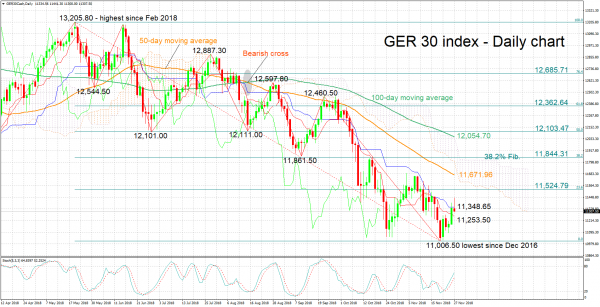The Germany 30 index gained ground after touching a two-year nadir of 11,006.50 last week and is currently trading roughly 300 points above the aforementioned bottom.
Despite the move up, the Tenkan- and Kijun-sen lines remain negatively aligned, which is indicative of a bearish short-term bias. However, the Kijun-sen has halted its decline, pointing to weakening negative momentum. Moreover, the stochastics are giving a bullish signal in the very short term, as the %K line is above the %D one and both are heading higher.
Immediate resistance to a stronger move up seems to be coming around the current level of the Kijun-sen at 11,348.65. An upside violation would turn the attention to 11,524.79, this being the 38.2% Fibonacci retracement level of the downleg from 13,205.80 to 11,006.50. Higher, the focus would turn to the 50-day moving average line at 11,671.96 – the Ichimoku cloud top lies close to this point – and then to the zone around the 38.2% Fibonacci mark at 11,844.31.
On the downside, a first line of support could occur around the Tenkan-sen at 11,253.50. Additional declines would increasingly bring within scope the two-year low of 11,006.80, with the region around it also encapsulating the 11,000 mark that may hold psychological importance. Lower still, the zone around 10,800 that halted advances numerous times in 2016, could also act as support.
The medium-term picture continues to look bearish. Evidently, the index is in a downtrend, recording lower highs and lower lows. In addition, trading activity is taking place below the 50- and 100-day MAs, as well as below the Ichimoku cloud.
To conclude, the medium-term outlook is negative, while the bearish short-term bias is being challenged at the moment. Year-to-date, the index is down by 15.2%.














